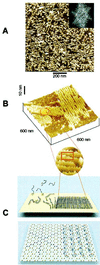In situ atomic force microscopy study of Alzheimer's beta-amyloid peptide on different substrates: new insights into mechanism of beta-sheet formation
- PMID: 10097098
- PMCID: PMC22355
- DOI: 10.1073/pnas.96.7.3688
In situ atomic force microscopy study of Alzheimer's beta-amyloid peptide on different substrates: new insights into mechanism of beta-sheet formation
Abstract
We have applied in situ atomic force microscopy to directly observe the aggregation of Alzheimer's beta-amyloid peptide (Abeta) in contact with two model solid surfaces: hydrophilic mica and hydrophobic graphite. The time course of aggregation was followed by continuous imaging of surfaces remaining in contact with 10-500 microM solutions of Abeta in PBS (pH 7.4). Visualization of fragile nanoscale aggregates of Abeta was made possible by the application of a tapping mode of imaging, which minimizes the lateral forces between the probe tip and the sample. The size and the shape of Abeta aggregates, as well as the kinetics of their formation, exhibited pronounced dependence on the physicochemical nature of the surface. On hydrophilic mica, Abeta formed particulate, pseudomicellar aggregates, which at higher Abeta concentration had the tendency to form linear assemblies, reminiscent of protofibrillar species described recently in the literature. In contrast, on hydrophobic graphite Abeta formed uniform, elongated sheets. The dimensions of those sheets were consistent with the dimensions of beta-sheets with extended peptide chains perpendicular to the long axis of the aggregate. The sheets of Abeta were oriented along three directions at 120 degrees to each other, resembling the crystallographic symmetry of a graphite surface. Such substrate-templated self-assembly may be the distinguishing feature of beta-sheets in comparison with alpha-helices. These studies show that in situ atomic force microscopy enables direct assessment of amyloid aggregation in physiological fluids and suggest that Abeta fibril formation may be driven by interactions at the interface of aqueous solutions and hydrophobic substrates, as occurs in membranes and lipoprotein particles in vivo.
Figures






References
-
- Lansbury P T., Jr Acc Chem Res. 1996;29:317–321.
-
- Selkoe D. Science. 1997;275:630–631. - PubMed
-
- Yankner B. Neuron. 1996;16:921–932. - PubMed
-
- Wisniewski T, Ghiso J, Frangione B. Neurobiol Dis. 1997;4:313–328. - PubMed
-
- Geula C, Wu C-K, Saroff D, Lorenzo A, Yuan M, Yankner B A. Nat Med. 1998;4:827–832. - PubMed
Publication types
MeSH terms
Substances
Grants and funding
LinkOut - more resources
Full Text Sources
Other Literature Sources

